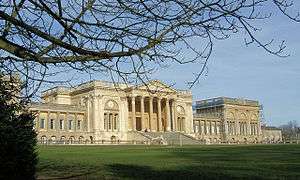1779 in architecture
The year 1779 in architecture involved some significant events.
| |||
|---|---|---|---|
|
Buildings and structures
|
Buildings and structures
Buildings
- St Paul's Square, Birmingham, England.
- South façade of Stowe House, England, completed in the neoclassical style based on a design by Robert Adam.
- Robert Adam completes his remodelling of Kenwood House on Hampstead Heath, London.
- New Church of Ireland Christ Church Cathedral, Waterford, designed by John Roberts, completed.
- Fridericianum in Kassel (Hesse), designed by Simon Louis du Ry, completed.
- Royal Saltworks at Arc-et-Senans, designed by Claude Nicolas Ledoux, completed.
- The Piece Hall in Halifax, West Yorkshire, opened 1 January 1779, Grade 1 listed Cloth Hall.
Awards
- Grand Prix de Rome, architecture: Guy de Gisors and Père François Jacques Lannoy.
Births
- April 10 – James Savage, English architect (died 1852)
- July 8 – Giorgio Pullicino, Maltese painter and architect (died 1851)
- Edward Lapidge, English architect (died 1860)
Deaths
- September 30 – Johan Christian Conradi, German-Danish master builder and architect (born 1709)
- November 9 – Carl Johan Cronstedt, Swedish architect and inventor (born 1709)
- Giuseppe Bonici, Maltese architect and military engineer (born 1707)
- Thomas Ivory, English builder and architect working in Norwich (born 1709)
- Richard Taliaferro, American architect working in Williamsburg, Virginia (born c.1705)
gollark: Also, you clearly don't.
gollark: Oh, so potatOS is non-stupid? Yay, you finally admit it.
gollark: It only works on nonexistent functions.
gollark: __index won't work.
gollark: ```osmarks@tyr ~> wscat -c wss://osmarks.tk/skynet/connectconnected (press CTRL+C to quit)> ```*accesses skynet*
This article is issued from Wikipedia. The text is licensed under Creative Commons - Attribution - Sharealike. Additional terms may apply for the media files.
